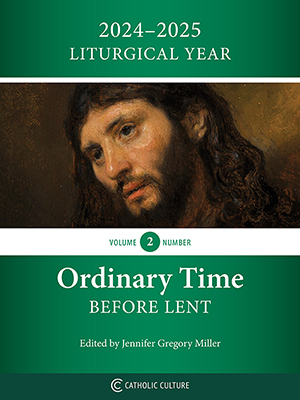Vatican II on Social Communication
By Dr. Jeff Mirus ( bio - articles - email ) | Feb 18, 2010 | In On the Documents of Vatican II
The second document promulgated by the Second Vatican Council was the Decree on the Means of Social Communication (Inter Mirifica), issued on December 4, 1963. It is extremely brief, its contents are predictable, and it is easily summarized in a single post. The essential concern of the Council here was to enjoin upon all Catholics the importance of using social media responsibly, for the common good, and to enhance the apostolic ministry of the Church.
The Council also mandated that the Holy See’s office of social communication issue a more complete pastoral instruction “to ensure that the principles and rules of the Council on the means of social communication be put into effect” (23). This was fulfilled in the lengthier Pastoral Instruction on the Means of Social Communication (Communio et progressio) in January of 1971. As a non-conciliar document it does not concern us here, but it is worth noting that its foreword states that the Council’s teachings on the media are not limited to Inter Mirifica, but may also be found in the Constitution on the Church in the Modern World, the Decree on Ecumenism, the Declaration on Religioius Freedom, the Decree on the Missionary Activity of the Church, and the Decree on the Pastoral Duties of Bishops. Still, one step at a time.
Inter Mirifica has just two (untitled) chapters. The first focuses on moral responsibility in the use of the media. The second covers the use of the media to enhance and expand the apostolate.
Moral Responsibility
The Council immediately affirms that the principles of the moral order must be applied to the media as elsewhere, but it notes that there are two aspects to this application: first, “the subject-matter, or content, which each medium communicates in its own way”; and second, “the circumstances in which the content is communicated.” Thus:
The circumstances can modify and even totally alter the morality of a production. In this regard, particular importance may attach to the manner in which any given medium achieves its effect. Its impact may be such that people, especially if they are insufficiently prepared, will only with difficulty advert to it, control it, or, if need be, reject it. (4)
With respect to both of these concerns, the Council stresses several points:
- The “right to information on the subjects that are of concern to men either as individuals or as members of society” which “demands that the content of the communication be true and—within the limits set by justice and charity—complete” (5);
- The need to establish a proper relationship “between the rights of art…and the moral law”, especially given increasing controversies arising from an “erroneous understanding either of ethics or of aesthetics,” for the moral law “alone is superior to and is capable of harmonizing all forms of human activity, not excepting art” (6);
- The importance of avoiding representations of moral evil which, instead of leading to “a deeper knowledge and analysis of man and to a manifestation of the true and the good”, actually undermine the good of souls through presentations which “lead all too easily to base desires in man wounded by original sin” (7).
The text goes on to indicate the proper exercise of responsibility among all parties. Thus the media consumer should possess “a properly motivated selectivity” which “would be wholly in favor of whatever excels in virtue, culture and art” while avoiding “whatever might be a cause or occasion of spiritual harm” (9). All consumers, “especially the young, should learn moderation and discipline in their use” of the media, while parents must remember that “it is their duty to see that entertainments and publications which might endanger faith and morals do not enter their houses and that their children are not exposed to them elsewhere” (10).
Those involved in the creation and dissemination of social media—journalists, writers, actors, designers, producers, exhibitors, distributors, operators, sellers, critics, etc.—self-evidently bear “a very great responsibility” because “they have power to direct mankind along a good path or an evil path by the information they impart and the pressure they exert”. The Council recommends the formation of professional associations “capable of imposing on their members…a respect for the moral law” (11). Civil authorities also bear particular responsibilities because of their role in fostering the common good. They are bound to ensure that “public morality and social progress are not gravely endangered through the misuse of these media” (12).
Apostolate
The second chapter concentrates on the need to make apostolic use of all the means of social communication. The Council begins by emphasizing that if “one really wants to form readers in a truly Christian spirit, an authentically Catholic press ought to be established and supported” and “the faithful should be reminded of the need to read and circulate the Catholic press if they are to judge all events from a Christian standpoint” (14). Brief attention is also given to radio, television, film and theater. The Internet, obviously, was not yet foreseen, but any set of specific media examples clearly serves to highlight the requirements of all.
The Council recommends appropriate training among Catholics for the apostolic use of the media. It is noteworthy that it does not regard a noble purpose as sufficient. Rather, apostolic use of the media “should excel by technical perfection and by effectiveness” (14). At the same time, appropriate training must not be merely technical; it must include “a complete formation, imbued with the Christian spirit and especially with the Church’s social teaching” (15).
The Council mandates that a day be set aside each year in every diocese “on which the faithful will be reminded of their duties” regarding Catholic social communications (18). It also states that all projects for Catholic social communications, regardless of who engages in them, are to be overseen in each diocese by the bishop, “to promote and, where they touch the public apostolate, to regulate them, including those under the control of exempt religious” (20). At the national level, the same office is to be undertaken by episcopal commissions or bishops appointed to the task (21); at the international level, such oversight belongs exclusively to the Holy See (22).
The Council concludes by expressing its confidence that:
all the sons of the Church will welcome the principles and regulations contained in this decree and will observe them faithfully. Thus they will not suffer damage as they use the media. Rather will the media, like salt and light, add savor to the earth and light to the world. (24)
Sadly, contemporary media, even in the Catholic world, seldom resembles what the Council envisioned; clearly the spiritual and moral principles in the Decree on the Means of Social Communication have been observed too often only in the breach. Nonetheless, the time may now be ripe. Once again, therefore, it is worth reminding ourselves of what the documents of the Second Vatican Council really say.
Previous in series: Vatican II on the Liturgy: Related Concerns
Next in series: Vatican II on the Church: Introduction
All comments are moderated. To lighten our editing burden, only current donors are allowed to Sound Off. If you are a current donor, log in to see the comment form; otherwise please support our work, and Sound Off!








